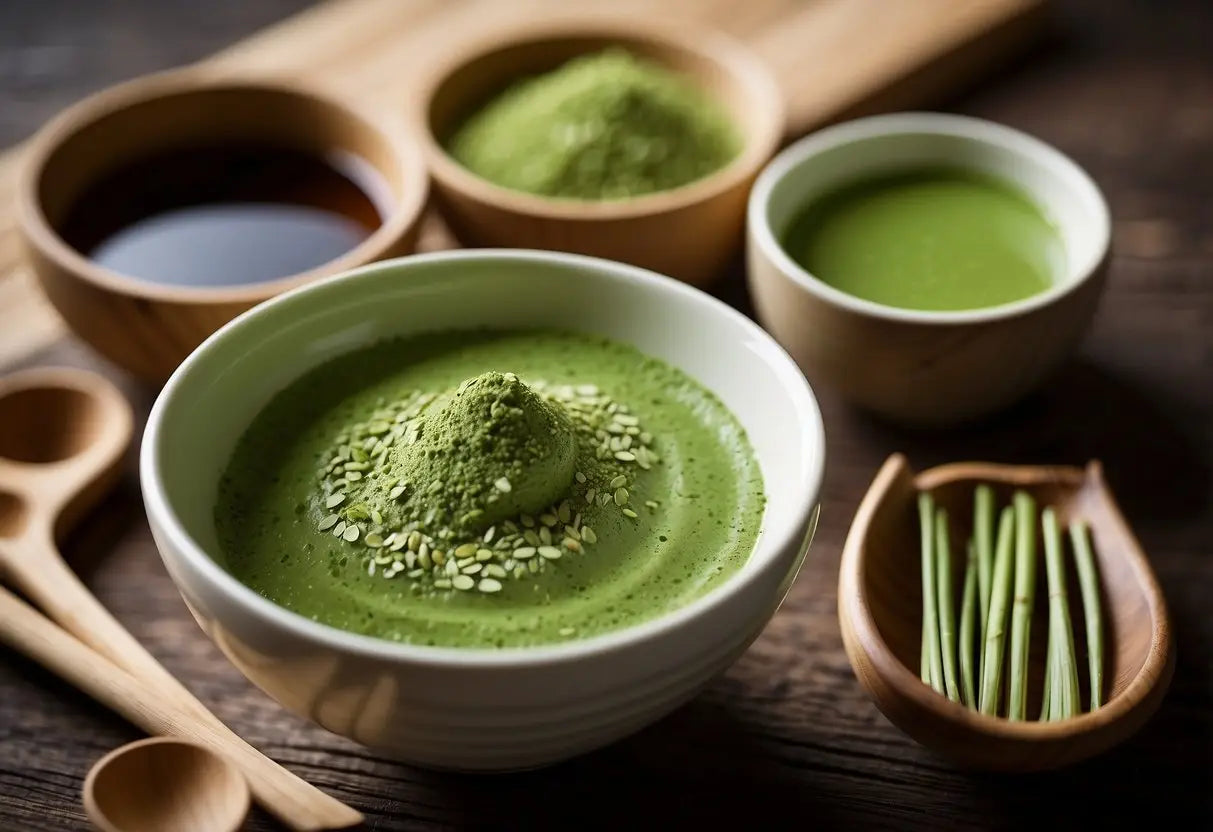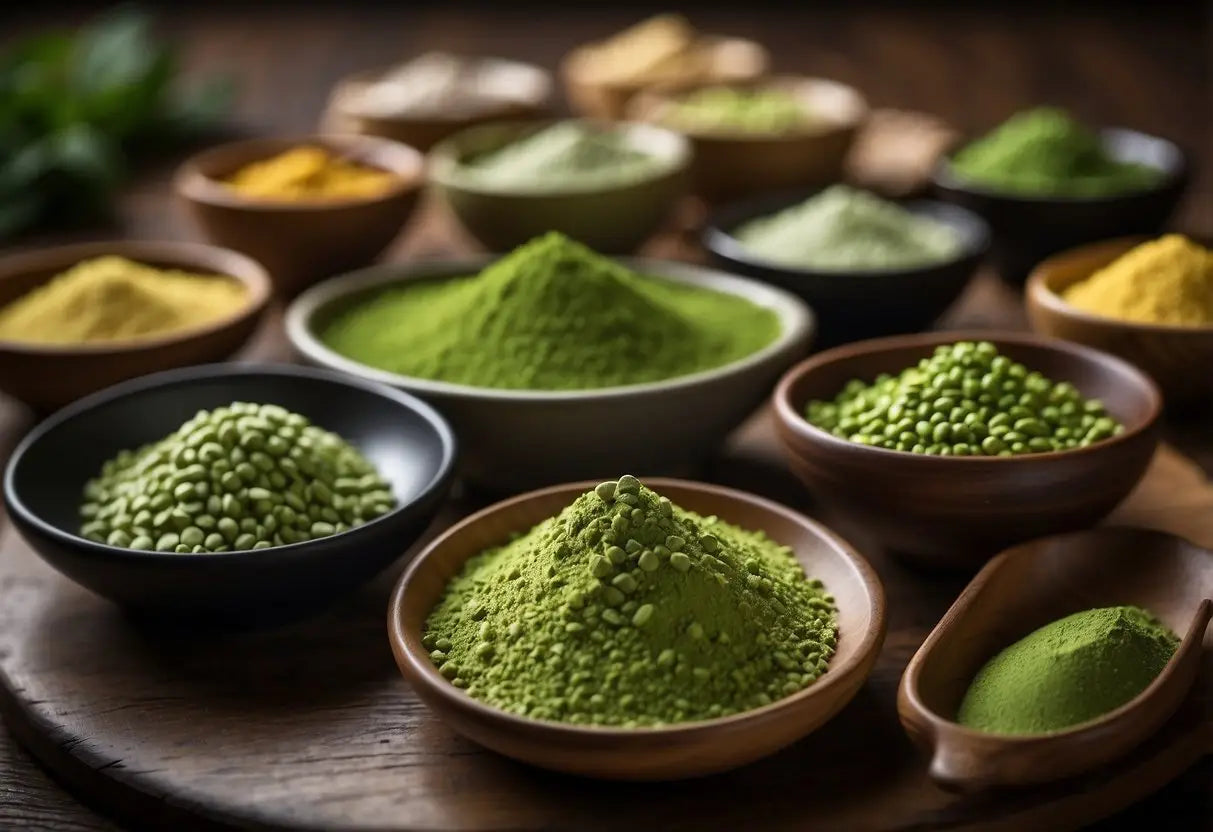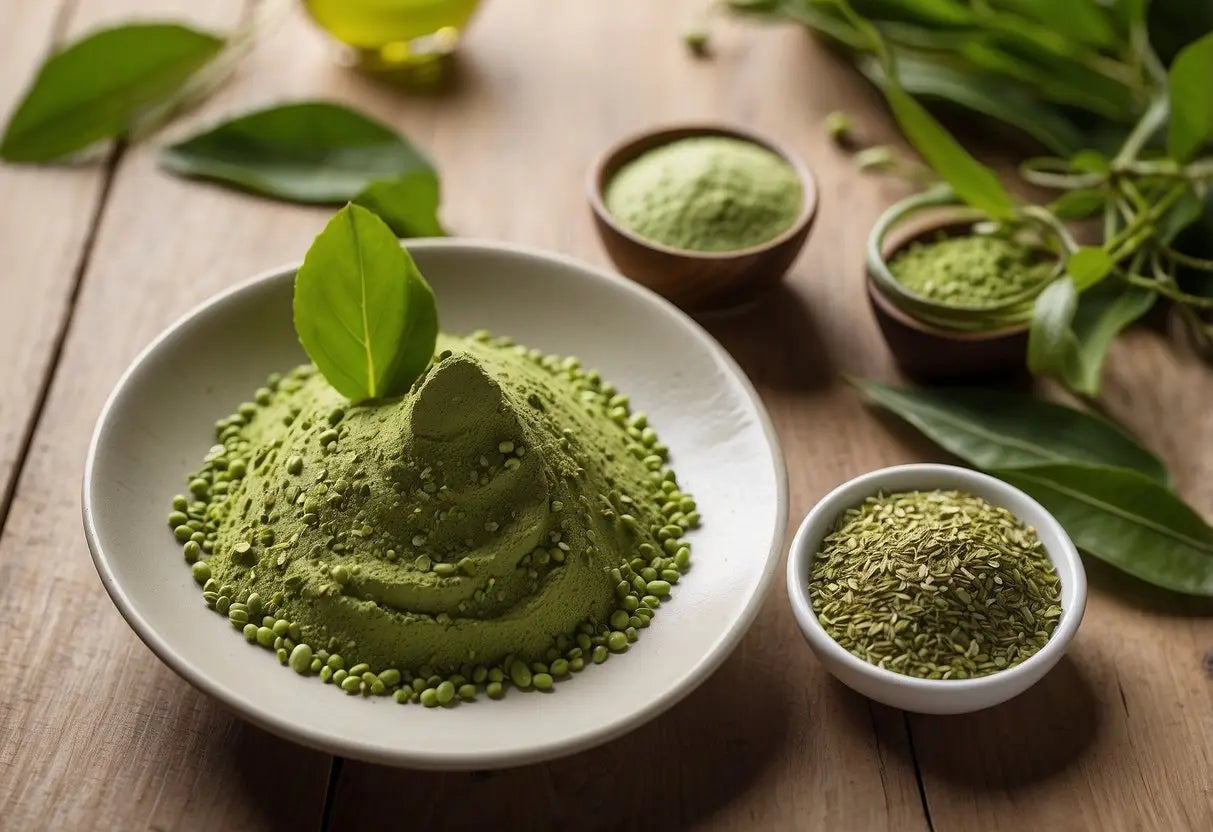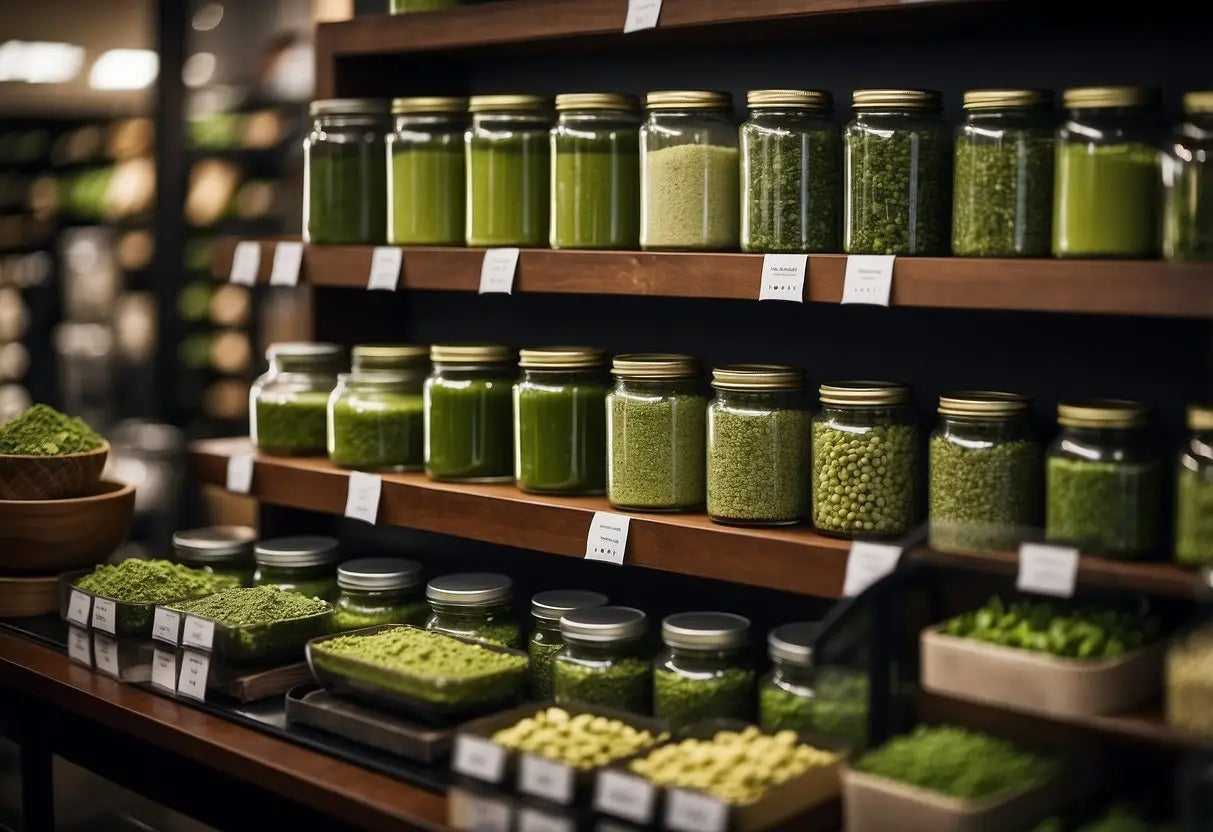Types of Matcha
Matcha, a specially grown and processed form of green tea, has a rich history rooted in Japanese culture. It's distinct due to its unique harvesting and processing methods, and holds deep cultural significance.
History and Origin
Matcha traces its roots back to Tang Dynasty China, where tea leaves were steamed and formed into bricks for storage. Japanese monks brought the practice to Japan in the 12th century.
Myoan Eisai, a Zen Buddhist monk, is credited with popularizing matcha in Japan. By the 16th century, matcha had become a central element of Japanese tea ceremonies, thanks to Sen no Rikyū, who refined the ritual.
Bestsellers
Processing
The process of creating matcha begins with growing the tea plants in the shade. This practice boosts chlorophyll levels, giving matcha its vibrant green color. After harvest, leaves are steamed to prevent oxidation, then dried and deveined.
The final step involves stone-grinding the dried leaves into a fine powder. This traditional method enhances the taste and nutritional profile of matcha, making it distinct from other green teas.
Cultural Significance
Matcha plays a crucial role in Japanese culture, especially within Chanoyu, the Japanese tea ceremony. This ritual emphasizes mindfulness, respect, and a deep appreciation for the ephemeral beauty of the moment.
Historically, matcha was also consumed by samurai warriors for its supposed energizing properties. Today, it continues to be valued both as a beverage and an ingredient in various foods and desserts in Japan and globally.
Types of Matcha

Matcha comes in various grades that suit different purposes and preferences. Each grade has distinct characteristics, quality, and uses.
Ceremonial Grade
Ceremonial Grade matcha is the highest quality and is often used in traditional Japanese tea ceremonies. It is made from the youngest tea leaves with the most vibrant green color. The texture is velvety, and the flavor is rich and smooth, with a natural sweetness and a slight umami taste.
This grade is often consumed without any additives like milk or sugar to appreciate its pure flavor. It is more expensive due to its labor-intensive production process and high-quality leaves. Ideal for: Special occasions, direct consumption, and traditional ceremonies.
Premium Grade
Premium Grade matcha is slightly lower in quality compared to ceremonial grade but still offers excellent flavor and color. It is made from slightly older tea leaves, resulting in a vibrant green color and a balanced mix of umami and astringency.
This grade is versatile and can be enjoyed on its own or mixed with other ingredients for lattes, smoothies, and desserts. It is more affordable than ceremonial grade while still offering a high-quality matcha experience. Ideal for: Daily consumption, mixed beverages, and culinary experimentation.
Culinary Grade
Culinary Grade matcha is the most economical and is specifically produced for cooking and baking. The leaves used are older and have a stronger, more robust flavor with a slightly bitter taste. The color is less vibrant compared to higher grades.
This grade is perfect for adding a distinct matcha flavor to various recipes without incurring the high cost of ceremonial or premium grades. It works well in cakes, cookies, ice cream, and savory dishes. Ideal for: Cooking, baking, and recipes requiring a stronger matcha flavor.
Lao Ban Zhang
Matcha Quality Indicators

Examining matcha involves considering its color, texture, taste, and aroma. High-quality matcha demonstrates specific traits in each of these indicators.
Color
High-grade matcha typically exhibits a vibrant, bright green hue. The color indicates the presence of chlorophyll, which is a result of shading the tea leaves during cultivation. Lower quality matcha may appear yellowish or brownish, indicating older leaves or stems were used. A vivid green color usually points to tender leaves harvested at peak freshness.
Texture
The texture of matcha can help you gauge its quality. It should have a fine, silky feel, similar to baby powder. If the powder feels gritty or coarse, it’s likely of lower quality. A smooth texture indicates that the leaves were properly ground using traditional stone mills, which produce an ultra-fine consistency.
Taste
Taste is a critical indicator of matcha quality. High-quality matcha should have a sweet, umami flavor with minimal bitterness. The sweetness comes from the amino acids in the tea leaves. Bitter or astringent tastes may suggest lower quality or improper preparation. The flavor profile should be complex, with layers of sweetness and earthiness.
Aroma
The scent of matcha also provides clues about its quality. Premium matcha will have a fresh, vegetal aroma with subtle grassy notes. If the matcha smells dull, stale, or has an off-putting odor, it likely indicates poor quality or that the matcha is not fresh. A rich, inviting aroma signifies a well-processed and fresh product.
Health Benefits

Matcha offers numerous health benefits that can positively impact your physical and mental well-being. Key attributes include its high antioxidant levels, support for mental clarity and energy, potential for aiding in weight loss, and benefits for heart health.
Antioxidant Content
Matcha is rich in catechins, a type of antioxidant. Epigallocatechin gallate (EGCG) is the most abundant and has been extensively studied for its health benefits. Antioxidants help protect your cells from damage caused by free radicals. Regular consumption of matcha can thereby promote cell health and potentially reduce the risk of chronic illnesses. Its ORAC (Oxygen Radical Absorbance Capacity) value is notably high, indicating its strong antioxidant capacity.
Mental Clarity and Energy
The amino acid L-theanine in matcha promotes relaxation without drowsiness. When combined with naturally occurring caffeine, it provides a sustained energy boost and enhances focus and concentration. Unlike the jittery energy from coffee, matcha offers a calm alertness. This makes it an excellent choice for tasks requiring extended mental effort. Regular consumption can help maintain alertness and improve productivity.
Weight Loss
Matcha can aid in weight management due to its ability to increase metabolism. The catechins, particularly EGCG, have been shown to enhance fat oxidation. Matcha may also improve exercise performance, allowing you to burn more calories. It can serve as a natural and effective supplement to your weight loss regimen. Incorporating matcha into your diet could provide additional support for achieving weight loss goals.
Heart Health
The catechins in matcha have been linked to improved cardiovascular health. Regular consumption can help reduce LDL cholesterol and lower blood pressure. These benefits contribute to a reduced risk of heart disease. Matcha's combination of antioxidants and anti-inflammatory properties supports overall heart function. It is a beneficial addition to a heart-healthy lifestyle.
Preparation and Usage
When preparing matcha, you can choose traditional methods involving ceremonial tools or modern approaches including lattes and smoothies. Matcha is also increasingly used in cooking and baking for its distinct flavor and vibrant color.
Traditional Preparation
Traditional preparation of matcha requires specific tools such as a bamboo whisk (chasen), a bamboo scoop (chasaku), and a matcha bowl (chawan). Start by sifting 1-2 teaspoons of matcha into the bowl to remove any clumps. Add a small amount of hot water, typically around 2 ounces at 175°F (80°C), and whisk vigorously in a zigzag motion until frothy. Focus on creating a smooth, lump-free mixture. This method respects the ceremonial roots of matcha, enhancing its flavor and texture.
Modern Applications
In modern settings, matcha finds its way into various beverages. Popular options include matcha lattes, where matcha powder is whisked into milk, or smoothies, where it blends seamlessly with fruits and vegetables. You can use a blender or frother for convenience. Matcha is versatile, easily adapted to individual taste preferences, and pairs well with both dairy and plant-based milks. It provides not only a caffeine boost but also a rich array of antioxidants.
Cooking and Baking
Matcha’s unique flavor and vibrant green color make it a favorite ingredient in cooking and baking. Use it in diverse recipes such as matcha cookies, cakes, and even savory dishes like matcha-flavored noodles. For baking, mix matcha powder directly with dry ingredients to ensure even distribution. Generally, 1-2 tablespoons are sufficient to infuse a dish with its characteristic taste and hue. Matcha enhances various recipes while adding nutritional benefits.
Purchasing Matcha

When purchasing matcha, you need to consider factors like authenticity, price ranges, and proper storage to ensure you get the best quality powder.
Identifying Authenticity
To ensure you're buying authentic matcha, examine the color, texture, and origin. Genuine matcha has a vibrant green hue, smooth texture, and is often from Japan. Regions like Uji, Kyoto, and Nishio are renowned for high-quality matcha. Additionally, look for certifications on the packaging which can indicate proper quality control.
Matcha should have a fresh, grassy aroma. Inferior quality may appear yellowish or brownish, indicating older or improperly processed leaves. Reading reviews and researching brands can also help in identifying authentic products.
Price Considerations
Matcha prices can vary significantly. High-quality ceremonial-grade matcha is more expensive, often used in traditional tea ceremonies. Prices can range from $30 to $50 per ounce. Culinary-grade matcha is cheaper, suitable for cooking and baking, costing around $10 to $20 per ounce.
Evaluate your needs before purchasing. If you're new to matcha or using it for recipes, culinary-grade might be sufficient. For traditional tea drinking, investing in ceremonial-grade is worthwhile. Always consider price in conjunction with expected use and quality.
Storage and Shelf Life
Proper storage is crucial to maintain matcha's freshness and flavor. Store matcha in an airtight container, away from light, heat, and moisture. A cool, dark place like a cupboard is ideal. Using a resealable bag or tin can help retain its quality.
Matcha has a shelf life of about 6 months once opened. Unopened containers can last up to a year. Note the packaging date and consume the product within these time frames to enjoy its full benefits. Regularly check for changes in color or aroma as indicators of deterioration.
← Older post Newer post →











